Recently, alarming news spread about the high freshwater consumption linked to the massive use of AI and, particularly, the growing daily use of ChatGPT. This has alarmed, worried, and angered more than one person aware of the global freshwater scarcity problem.
Therefore, I decided to verify it in depth, with great detail, using manually reviewed sources to determine if it's a myth or a reality:
In-depth Analysis of the Fact
AI models like ChatGPT, Gemini, and Claude are hosted in enormous data centers packed with servers that generate a lot of heat when operating. To maintain the proper temperature, freshwater is used to cool them and preserve their good performance.

Saltwater is not an option! It conducts electricity, can cause short circuits, and accelerates chip oxidation.
This cooling process occurs at two specific times: when the AI is being trained (a process that happens only once) and when each of us uses ChatGPT or any other AI for queries.
Water Consumption During Training
The GPT-3 model, ChatGPT's predecessor, consumed about 5.4 million liters during training, considering both server cooling and the water needed for electricity generation. This figure is insignificant when compared to the agricultural sector's consumption: 2,722 trillion liters, or with industrial consumption: 734 trillion liters of freshwater, and these consumptions occur annually, not just once.
While training has been the focus of sustainability debates, daily use is emerging as the main future concern.
Water Consumption During Daily AI Use
On May 14, 2025, researchers from the University of Rhode Island and the University of Tunis published a comprehensive report quantifying the environmental impact of artificial intelligence (energy, water, and carbon) after analyzing 30 models, including those developed by OpenAI, Anthropic, Meta, and DeepSeek.

In this report, we see that DeepSeek-R1 is the most water-“intensive” model, consuming ≈234 milliliters for every 10,000 tokens (equivalent to a total of 20–50 daily messages from an average user). It also has the highest energy consumption, according to the researchers' analysis.
The o3 model (OpenAI's most advanced model to date) consumes ≈134 milliliters for the same 10,000-token load, placing it in a similarly high range. In contrast, the GPT-4 Turbo model (used in the free version of ChatGPT) consumes only ≈33 milliliters for the same token amount. Source: arxiv.org
| Model | 1,000 tokens (milliliters) | 10,000 tokens (milliliters) |
|---|---|---|
| DeepSeek-R1 | 201.87 | 234.12 |
| o3 (reasoning) | 73.02 | 133.75 |
| GPT-4.5 (dresearch) | 69.90 | 103.98 |
| GPT-4 Turbo (free) | 23.04 | 33.16 |
| Claude-3.7 Sonnet | 9.18 | 18.21 |
| LLaMA-3.2-vision 90B | 11.37 | 18.05 |
| GPT-4o (all tasks) | 4.14 | 6.10 |
| LLaMA-3.2-vision 11B | 0.71 | 3.10 |
Although these values may seem low when talking about milliliters, if we consider 100 million daily queries, the total impact is more alarming. This equates to 33 thousand liters of water, using the GPT-4 Turbo model as a reference.
This might seem concerning until you compare it with the water used by, for example, a hot shower.
Water Consumption of Your Daily Habits at Home
A study by IWA Publishing (a leading publisher in the water field) showed that the average water consumption per person is 175 liters per day. To do this, the publisher developed a theoretical model to stochastically describe 21 water-requiring activities.

Among the activities mentioned in the study are showering, washing clothes, flushing the toilet, washing dishes, and even washing the car. 175 liters daily is a remarkably high amount, and even a 1 million-token conversation with the most water-intensive model wouldn't come close to that consumption: it would be merely 20 liters.

Practically any daily activity consumes more water than an artificial intelligence model would use:
| Daily Activity | Consumption (milliliters) | Source |
|---|---|---|
| Washing clothes | 117,000 | thespruce.com |
| Shower (8min) | 60,000 | epa.gov |
| Washing dishes | 23,000 | wikipedia.org |
| Flushing the toilet | 6,000 | wikipedia.org |
| Faucet use (30s) | 1,900 | wikipedia.org |
| DeepSeek-R1 (10K) | 234 | arxiv.org |
| GPT-4 Turbo (10K) | 33 | arxiv.org |
If 100 million people take an 8-minute hot shower daily, they would consume 6 billion liters of freshwater.
And that's nothing; washing your car requires approximately 440 liters of freshwater. Do the math yourself! cfpub.epa.gov
Conclusion / Verdict
This comparison clearly shows that, as of today, the water footprint of using AI (234 milliliters per session) is insignificant compared to daily activities like showering, washing clothes, or even washing dishes. Therefore, we can confidently answer with a resounding NO to the question: Does AI consume more water than your daily habits?.
It's completely FALSE!
This doesn't mean we should stop worrying about water consumption; on the contrary, thinking about shorter showers, spacing out car washes, or even reducing hamburger consumption can save much more drinking water than stopping your daily use of modern artificial intelligence.

Every drop counts! 💧 Small daily changes make an impact when we adopt them together. Getting informed, sharing, and acting today is ensuring water for tomorrow. 🌎
References
- Making AI Less “Thirsty”: Uncovering and Addressing the Secret Water Footprint of AI Models. https://arxiv.org/abs/2304.03271 https://arxiv.org/pdf/2304.03271
- How Hungry is AI? Benchmarking Energy, Water, and Carbon Footprint of LLM Inference. https://arxiv.org/abs/2505.09598 https://arxiv.org/pdf/2505.09598
- AI's Challenging Waters. https://cee.illinois.edu/news/AIs-Challenging-Waters
- Water footprint. https://en.wikipedia.org/wiki/Water_footprint
- About IWA Publishing. https://iwaponline.com/pages/About_IWA_Publishing
- Defining domestic water consumption based on personal water-use activities. https://iwaponline.com/aqua/article/70/7/1002/83539/Defining-domestic-water-consumption-based-on
- Save Water and Energy by Showering Better. https://www.epa.gov/sites/default/files/2017-02/documents/ws-ourwater-shower-better-learning-resource_0.pdf
- How Much Water Is Your Washing Machine Using? https://www.thespruce.com/how-much-water-does-a-washing-machine-use-8694300
- Residential water use in the U.S. and Canada. https://en.wikipedia.org/wiki/Residential_water_use_in_the_U.S._and_Canada
- Microsoft unveils zero-water cooling for AI data centres. https://sustainabilitymag.com/articles/microsoft-unveils-zero-water-cooling-for-ai-data-centres
- AI Is Accelerating the Loss of Our Scarcest Natural Resource: Water. https://www.forbes.com/sites/cindygordon/2024/02/25/ai-is-accelerating-the-loss-of-our-scarcest-natural-resource-water/
- ChatGPT Pricing. https://openai.com/chatgpt/pricing/
- How can OpenAI reduce water usage in server cooling? https://community.openai.com/t/how-can-openai-reduce-water-usage-in-server-cooling/1195434
- Google Water Stewardship. https://sustainability.google/commitments/water/
- Car Washing - What is a Watershed?. https://cfpub.epa.gov/npstbx/files/KSMO_CarWashing.pdf
- Number of ChatGPT Users (April 2025 Updated) https://shahidshahmiri.com/chatgpt-users/
